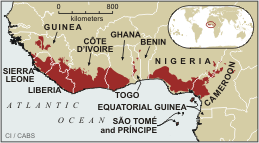Guinean Forests of West Africa Biodiversity Hotspot
All data and map are from www.biodiversityhotspots.org
 The lowland forests of West Africa are home to more than a quarter of Africa’s mammals, including more than 20 species of primates. Logging, mining, hunting and human population growth are placing extreme stress on the forests, however, threatening species such as the Jentinka’s duiker, pygmy hippopotamus, and scattered populations of western chimpanzees. Five Endemic Bird Areas lie partly or entirely within the hotspot.
The lowland forests of West Africa are home to more than a quarter of Africa’s mammals, including more than 20 species of primates. Logging, mining, hunting and human population growth are placing extreme stress on the forests, however, threatening species such as the Jentinka’s duiker, pygmy hippopotamus, and scattered populations of western chimpanzees. Five Endemic Bird Areas lie partly or entirely within the hotspot.
| Hotspot Original Extent (km2) | 620,314 |
| Hotspot Vegetation Remaining (km2) | 93,047 |
| Endemic Plant Species | 1,800 |
| Endemic Threatened Birds | 31 |
| Endemic Threatened Mammals | 35 |
| Endemic Threatened Amphibians | 49 |
| Extinct Species | 0 |
| Human Population Density (people/km2) | 137 |
| Area Protected (km2) | 108,104 |
| Area Protected (km2) in Categories I-IV* | 18,880 |
Overview
The Guinean Forests of West Africa hotspot encompasses all of the lowland forests of political West Africa, stretching from Guinea and Sierra Leone eastward to the Sanaga River in Cameroon. This includes the countries of Liberia, Ivory Coast, Ghana, Togo, Benin, and Nigeria, which maintain remnant fragments of the forests. The hotspot also includes four islands in the Gulf of Guinea: Bioko and Annobon, which are both part of Equatorial Guinea, and Sao Tomé and Principe, which together form an independent nation. Bioko is a continental-shelf island, whereas the remaining three are oceanic.
The hotspot includes two distinct sub-regions, which incorporate several important forest refugia created by the retraction and fragmentation of forests during the Pleistocene Epoch. The first sub-region, Upper Guinea, stretches from southern Guinea into eastern Sierra Leone and through Liberia, Ivory Coast and Ghana into western Togo. The second sub-region, Nigeria-Cameroon, extends along the coast from western Nigeria to the Sanaga River in southwestern Cameroon. The two sub-regions are separated by the Dahomeny Gap in Benin, an area of farmland, savannah and highly degraded dry forest. The hotspot supports several important montane regions, including the Cameroon Highlands (Mt. Cameroon, at 4,095 meters, is the highest peak in West Africa) and the Nimba Highlands.
The Guinean forests consist of a range of distinct vegetation zones varying from moist forests along the coast, freshwater swamp forests (for example, around the Niger Delta), semi-deciduous forests inland with prolonged dry seasons. Of all West African countries, only Liberia lies entirely within the moist forest zone, although a substantial portion of Sierra Leone also falls within the boundaries.
A unique and threatened biodiversity
Plants
The Guinean Forests hotspot is home to an estimated 9,000 vascular plant species, about 20 percent (1,800 species) of which are thought to be endemic (25 percent). The flora of this hotspot is closely related to the flora of central Africa, and most genera are widespread throughout both regions. However, West Africa has high levels of local endemism at the species level. Tai National Park in Côte d’Ivoire, Mount Nimba on the Liberia, Guinea and Côte d’Ivoire border, Cross River National Park in Nigeria, and Mount Cameroon are areas known to support significant assemblages of endemic plant species. Nearly 2,500 plant species have been recorded on Mount Cameroon. Because of their relative isolation from the rest of the hotspot, the Gulf of Guinea Islands also support highly endemic flora; approximately 185 species are endemic to these islands, and São Tomé and Príncipe each have a single-island endemic plant genus.
Among the many flagship plant species in this hotspot are a number of economically important species. The oil palm ( Elaeis guineensis), widely planted throughout the tropics for oil production, is native to the hotspot, while valuable timber species include the African ebony ( Diospyros gracilis), two genera of African mahogany ( Entandophragma and Khaya), and iroko ( Milicia excelsa), which is widely exploited.
Birds
The Guinean Forests of West Africa support nearly 785 bird species, of which roughly 75 species and seven genera are endemic. These forests are home to 10 species of hornbills, large frugivores that fill an important ecological function in tropical forests as seed dispersers. Dozens of the region’s bird species are threatened by extensive forest clearing that is occurring throughout the hotspot.
BirdLife International has recognized six Endemic Bird Areas as lying partly or entirely within the hotspot. The Upper Guinea Forests EBA has 15 endemic bird species, and the Cameroon Mountains EBA, which includes the island of Bioko, is the sole habitat of nearly 30 bird species. These montane regions support a number of endemics: the Mount Cameroon francolin ( Francolinus camerunensis, EN) and the Mount Cameroon speirops ( Speirops melanocephalus, VU) are endemic to Mount Cameroon, while the Mount Kupe bush-shrike ( Malaconotus kupeensis, EN) is largely confined to Mount Kupe, where only 21 square kilometers of habitat remains (it has recently been discovered at two additional localities). The conservation of the forests of Mount Oku is the last remaining hope for two species, Bannerman’s turaco ( Tauraco bannermani, EN) and the banded wattle-eye ( Platysteira laticincta, EN), which are restricted to montane forests in the Bamenda-Banso highlands. The islands of Sao Tome, Principe and Annobon in the Gulf of Guinea, each of which is an entire EBA, add several endemic and interesting bird species to the region’s avifauna including the dwarf olive ibis ( Bostrychia bocagei, CR). The giant sunbird ( Nectarinia thomensis, VU), the giant weaver ( Ploceus grandis), and two endemic genera, Amaurocichla and Neospiza, both represented by threatened single species, are also restricted to these islands. The sixth EBA, the Cameroon and Gabon lowlands, is marginal to the hotspot.
Mammals
Mammal diversity in the hotspot is very high. West Africa’s estimated 320 species represent more than a quarter of the roughly 1,100 total mammal species found on the entire continent of Africa. More than 60 of these mammals are endemic to the region, including 18 species of primate.
The Guinean Forests are renowned for their primate diversity, with nearly 30 distinct species. These forests have been identified as some of Africa’s most critical primate conservation areas. As many as six species are endemic to the Upper Guinea forests, and nine are endemic to the forests of Nigeria and Cameroon. There are four endemic subspecies on Bioko Island. Among the species found within the Guinean Forests the striking Diana monkey ( Cercopithecus diana, EN) is an important indicator of forest health because of its dependence on high-canopy forests, while the olive colobus ( Procolobus verus) is the world’s smallest colobine monkey. The hotspot also has populations of two of Africa’s great apes, including remaining scattered populations of chimpanzees ( Pan troglodytes, EN) and a small population of western lowland gorillas ( Gorilla gorilla gorilla, EN) on the Nigeria-Cameroon border.
While the West African forests are famous for their primates, they are also the home of seven endemic genera, including the rare pygmy hippopotamus ( Hexaprotodon liberiensis, VU) and the Liberian mongoose ( Liberiictis kuhnii, EN). Other flagship species include two species of duiker, Jentink’s duiker ( Cephalophus jentinki, VU) and the zebra duiker ( Cephalophus zebra, VU), endemic to the Guinean forest and two of the rarest antelopes in the world. The countries that make up the hotspot have a combined population of some 5,000 elephants ( Loxodonta africana, VU), though many populations reside in savannah habitats outside to the hotspot.
Reptiles
While reptiles are not adequately documented in West Africa, preliminary analysis suggests that more than 200 species, a quarter of which are endemic, are found in the region, including more than 100 species of snakes and all three species of African crocodiles. Among the distinctive endemics are the Los Archipelago worm lizard ( Cynisca leonina), Benson’s mabuya ( Mabuya bensonii), and the Liberia worm snake ( Typhlops leucostictus).
Amphibians
Amphibians are also poorly documented in the region, but it is estimated that almost 225 amphibians inhabit the hotspot, including more than 80 endemics. Many additional species are likely to be discovered; for example, 11 new frog species have been discovered in the last decade alone. It is clear the hotspot supports a high diversity of tree frogs. One distinctive endemic species is the Mount Nimba toad ( Nimbaphrynoides occidentalis, CR), which gives birth to fully developed toadlets after a gestation period of nine months. The huge and threatened Goliath frog ( Conraua goliath, EN) also occurs in this hotspot; this species can grow as large as 30 centimeters long and weigh 3.3 kilograms.
Freshwater Fishes
Fish diversity is quite remarkable in the Guinean Forests hotspot, with more than 510 freshwater fishes, 35 percent of which are thought to be endemic. About a quarter of the world’s 350 species of killifish live here, half of which are endemic. Cichlid fishes are also prominent, with more than half of the over 60 species endemic to the hotspot. Four of the five endemic genera of cichlids are found only in Lake Barombi Mbo in northwest Cameroon.
For more information on the Hotspot, concerning Human Impacts, Conservation Action and species go to http://www.biodiversityhotspots.org/xp/hotspots/west_africa/Pages/biodiversity.aspx

